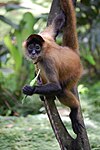Portal:Primates
The Primates Portal A primate is a member of the biological order Primates, the group that contains lemurs, the aye-aye, lorisids, galagos, tarsiers, monkeys, and apes, with the last category including great apes. With the exception of humans, who inhabit every continent on Earth, most primates live in tropical or subtropical regions of the Americas, Africa and Asia. Primates range in size from the 30-gram (1 oz) pygmy mouse lemur to the 200-kilogram (440 lb) mountain gorilla. According to fossil evidence, the primitive ancestors of primates may have existed in the late Cretaceous period around 65 mya (million years ago), and the oldest known primate is the Late Paleocene Plesiadapis, c. 55–58 mya. Molecular clock studies suggest that the primate branch may be even older, originating in the mid-Cretaceous period around 85 mya. Primates exhibit a wide range of characteristics. Some primates do not live primarily in trees, but all species possess adaptations for climbing trees. Locomotion techniques used include leaping from tree to tree, walking on two or four limbs, knuckle-walking, and swinging between branches of trees (known as brachiation). Primates are characterized by their large brains relative to other mammals. These features are most significant in monkeys and apes, and noticeably less so in lorises and lemurs. Many species are sexually dimorphic, which means males and females have different physical traits, including body mass, canine tooth size, and coloration.
Selected article
The Hoollongapar Gibbon Sanctuary, formerly known as the Gibbon Wildlife Sanctuary or Hollongapar Reserve Forest, is an isolated protected area of evergreen forest located in Assam, India. The sanctuary was officially constituted and renamed in 1997. Set aside initially in 1881, its forests used to extend to the foothills of the Patkai mountain range. Since then, the forest has been fragmented and surrounded by tea gardens and small villages. In the early 1900s, artificial regeneration was used to a develop well-stocked forest, resulting in the site's rich biodiversity. The Hoollongapar Gibbon Sanctuary contains India's only gibbons – the hoolock gibbons, and Northeastern India's only nocturnal primate – the Bengal slow loris. The upper canopy of the forest is dominated by the Hollong tree (Dipterocarpus macrocarpus), while the Nahar (Mesua ferrea) dominates the middle canopy. The lower canopy consists of evergreen shrubs and herbs. The habitat is threatened by illegal logging, encroachment of human settlements, and habitat fragmentation.
Selected picture A Barbary macaque (Macaca sylvanus) by the Upper Rock Nature Reserve in Gibraltar. Although the species is commonly referred to as the "Barbary ape", it is in fact a monkey. The Barbary macaque population in Gibraltar is the last in the whole of the European continent. A popular belief holds that as long as Barbary macaques exist on Gibraltar, the territory will remain under British rule. CategoriesSelected species Near Threatened (IUCN 3.1)|Near Threatened The ring-tailed lemur (Lemur catta) is a large strepsirhine primate and the most recognized lemur due to its long, black and white ringed tail. Like all lemurs it is endemic to the island of Madagascar. It is omnivorous and the most terrestrial of lemurs. The animal is diurnal, being active exclusively in daylight hours. The ring-tailed lemur is highly social, living in groups of up to 30 individuals. As one of the most vocal primates, the ring-tailed lemur utilizes numerous vocalizations including group cohesion and alarm calls. Despite being listed as Near Threatened by the IUCN Red List and suffering from habitat destruction, the ring-tailed lemur reproduces readily in captivity and is the most populous lemur in zoos worldwide, numbering more than 2000 individuals. It typically lives 16 to 19 years in the wild and 27 years in captivity. Did you know?
Primate lists
WikiProjectsThings to do
Associated WikimediaDiscover Wikipedia using portals |

















